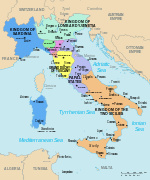Order of Saint Joseph
You can help expand this article with text translated from the corresponding article in Italian. (October 2022) Click [show] for important translation instructions.
|
This article needs additional citations for verification. (June 2023) |
| Order of Saint Joseph | |
|---|---|
 Badge of the order | |
| Type | Dynastic order |
| Established | 9 March 1807 |
| Motto | UBIQUE SIMILIS |
| Founder | Ferdinand III, Grand Duke of Tuscany |
| Grand Master | Archduke Sigismund of Austria |
| Grades | Knight Grand Cross Commander Knight |
Ribbon of the order | |

The Order of Saint Joseph was instituted on 9 March 1807 by Ferdinand III, Grand Duke of Tuscany during his reign as Grand Duke of Würzburg.[1] It was transformed into a Tuscan Roman Catholic Dynastic Order in 1817.[1]
The constitution of the Order was promulgated in March 1817, with amendments in August 1817. The order was divided into civil and military categories but these are now defunct. It is given to reward services towards Tuscan culture and civilisation and to the Grand Ducal House as a whole. [citation needed] The Order is divided into three levels:
- Knights Grand Cross, numbering thirty
- Commander, numbering sixty
- Knights, numbering one hundred and fifty
These numbers excluded Sovereigns, Heads of State, and Princes of the Grand Ducal House and other Royal Houses, Cardinals of the Holy Roman Church and Tuscan Metropolitan Archbishops. All had to be Catholics. The number of women members cannot exceed fifty, excluding Princesses of the Grand Ducal and other Royal Houses, wives of Heads of State and Dames of the Order of Saint Stephen. It is permitted for non-nobles to be admitted into the Order of the level of Grand Cross in cases of exceptional merit. Dames wear the same Cross as Knights but from a bow on the left breast. Dame Grand Crosses wear the Cross hanging from a Riband like the Knights but without the Star.
On 20 December 1866, Ferdinand IV and his children rejoined the imperial household, and the House of Tuscany ceased to exist as an already sovereign branch, being absorbed into the Austrian imperial branch; Ferdinand was allowed to retain his fons honorum vita natural durante, while his children became only imperial princes (Archdukes/Archiduchesses of Austria) and no longer princes/princesses of Tuscany. In 1870, Ferdinand IV renounced his remaining political rights to claim sovereignty over the Grand Duchy of Tuscany in favour of Emperor Franz Joseph I of Austria [2][3][4][5] and with him all political claims to Tuscany for all descendants of Leopoldo.[6] In fact, after the death of Grand Duke Ferdinand IV in 1908, Emperor Franz Joseph I had forbidden the assumption of the titles of Grand Duke, Prince or Princess of Tuscany: none of Ferdinand IV's children born after 1866 called themselves Prince or Grand Duke of Tuscany, nor did they take possession of the extinct dynastic orders already conferred by the Grand Dukes of Tuscany.[7][8][9]
 | ||
Recipients
[edit]- Grand Masters
- Commanders
- Knights
- Giovanni Battista Amici
- Felice Pasquale Baciocchi
- Friedrich von Beck-Rzikowsky
- Gino Capponi
- Jean-François Champollion
- Pavel Nikolaievich Demidov
- Ibrahim Pasha
- Anatoly Nikolaievich Demidov, 1st Prince of San Donato
- Giovanni Dupré
- Alphonse de Lamartine
- Maximilian II of Bavaria
- Philipp Albrecht, Duke of Württemberg
- Bettino Ricasoli
- Federico Sclopis
- Federico Sclopis
References
[edit]- ^ a b Burke, Bernard (1858). The Book of Orders of Knighthood and Decorations of Honour of All Nations: Comprising a Historical Account of Each Order, Military, Naval, and Civil, from the Earliest to the Present Time, with Lists of the Knights and Companions of Each British Order ... Hurst and Blackett. pp. 352–353.
- ^ Bernd Braun: Das Ende der Regionalmonarchien in Italien. Abdankungen im Zuge des Risorgimento. In: Susan Richter, Dirk Dirbach (Hrsg.): Thronverzicht. Die Abdankung in Monarchien vom Mittelalter bis in die Neuzeit. Böhlau Verlag, Köln, Weimar, Wien 2010, pagg. 251–266
- ^ Benedikt, Heinrich, Kaiseradler über dem Apennin. Die Österreicher in Italien 1700 bis 1866. Vienna: Herold Verlag, 1964
- ^ Karl Vocelka, Lynne Heller: Die private Welt der Habsburger: Leben und Alltag einer Familie, Styria, 1998, pag. 253, colonna I
- ^ Das Haus Habsburg: Vorspann ; Register ; Quellen ; Das Haus Alt-Habsburg ; Das Haus Habsburg-Lothringen, Alois Jahn, Selbstverl, 2002, pag. 59, 65
- ^ Annuario della Nobiltà Italiana, XXXII edizione, 2014, parte I
- ^ Rivista Araldica, anno 1913, volume 11, pagina 381, Roma, Collegio Araldico: "Da informazione ufficiale assunta a Vienna togliamo quanto segue «A Sua Altezza I. R. il defunto Granduca Ferdinando IV di Toscana era stato permesso dall'Impero austro-ungarico e dagli Stati dell'Impero germanico, di conferire i tre Ordini toscani, inerenti alla Sovranità, che anche spodestato, rimase all'Augusto principe fino alla sua morte. Il titolo di Principe di Toscana fu solo autorizzato ai membri della famiglia granducale nati prima del 1866. Dopo la morte del Granduca (1908) tutti gli augusti figli del defunto dovettero solennemente rinunciare ad ogni qualsiasi diritto di cui personalmente ed eccezionalmente godeva il padre. Quindi il Gran Magistero dell'Ordine di S. Stefano per volontà di S. M. l'Imperatore e Re è terminato col defunto granduca, né più sarebbe accettato dagli augusti principi lorenesi"
- ^ SILVA TAROUCA, Adler, Vienna, 1954, p. 165
- ^ Annuario della Nobiltà Italiana, XXXIII edizione, 2021, parte I, Asburgo Lorena
Bibliography
[edit]- Gregor Gatscher-Riedl, Mario Strigl, Die roten Ritter. Zwischen Medici, Habsburgern und Osmanen. Die Orden und Auszeichnungen des Großherzogtums Toskana. Vienna, Neue Welt Verlag, 2014. ISBN 978-3-9503061-5-6.




